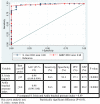Exists a role for serum irisin in Egyptian Behcet's patients with subclinical atherosclerosis?
- PMID: 36112245
- PMCID: PMC9823020
- DOI: 10.1007/s10067-022-06368-9
Exists a role for serum irisin in Egyptian Behcet's patients with subclinical atherosclerosis?
Abstract
Objectives: To examine the serum irisin level in a group of Behcet's disease patients, its association with illness parameters, and its utility in diagnosing subclinical atherosclerosis.
Methods: This randomized case-control study included 50 patients and 50 age- and sex-matched controls. Carotid Doppler ultrasound for the measurement of the carotid artery intima-media thickness (CIMT) and ankle-brachial pressure index (ABPI) were performed. A clinical evaluation, lipogram, and serum irisin were also performed.
Results: Between the patients and the control group, there was a significant difference in CIMT, S. irisin level, and ankle-brachial pressure index; however, gender and BMI did not significantly affect CIMT, ABPI, or S. irisin level. CIMT demonstrated a substantial negative correlation with both S. irisin and ABPI (r = - 0.62, P 0.0001). With a sensitivity of up to 94.30% and a specificity of 93.30%, the ROC analysis revealed that a decrease in S. irisin level in Behcet's patients was indicative of subclinical atherosclerosis. The drop in the ABPI level demonstrated a sensitivity of up to 94.30% and a specificity of 100%.
Conclusion: Subclinical atherosclerosis is prevalent among Egyptian Behcet's patients, and S. irisin can be employed as a biomarker for diagnosing subclinical atherosclerosis in Behcet's illness. Key Points • Serum irisin has been studied in numerous autoimmune disorders as a marker for subclinical atherosclerosis, although its importance in Behcet's disease remains unclear (BD). • We examined the change in serum irisin levels in Behcet's disease patients and healthy controls. In addition, its association with carotid artery intima-media thickness (CIMT) and ankle-brachial pressure index was investigated (ABPI). • Changes in serum irisin levels are significant in BD, and a decrease in irisin level indicates subclinical atherosclerosis.
Keywords: Atherosclerosis; Egyptian Behcet’s disease; Serum irisin.
© 2022. The Author(s).
Figures
References
Publication types
MeSH terms
Substances
LinkOut - more resources
Full Text Sources
Medical


